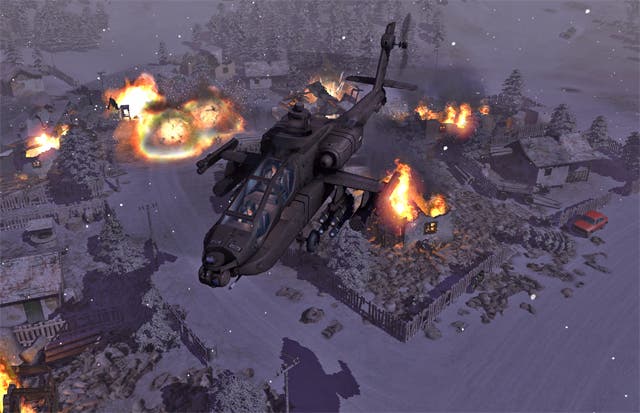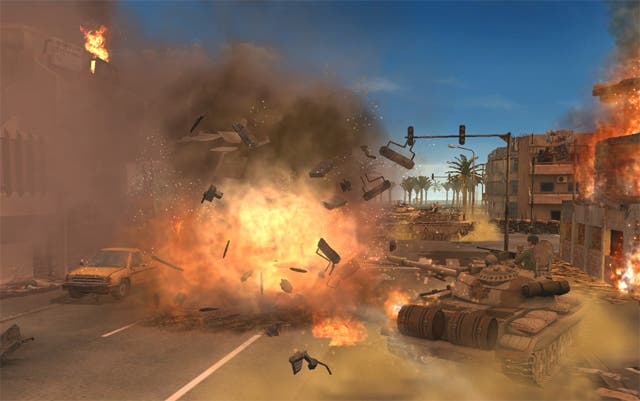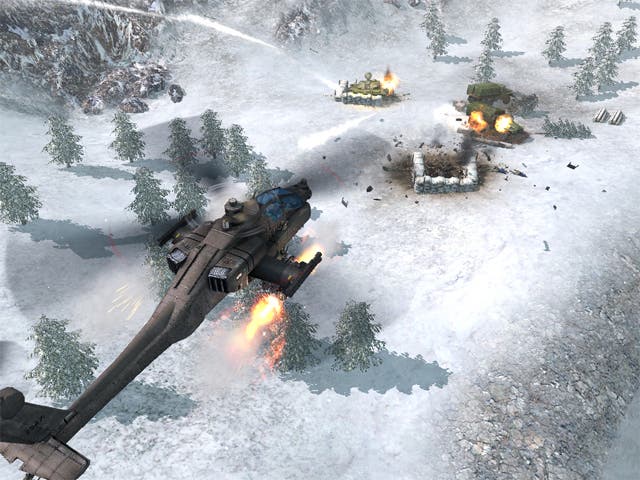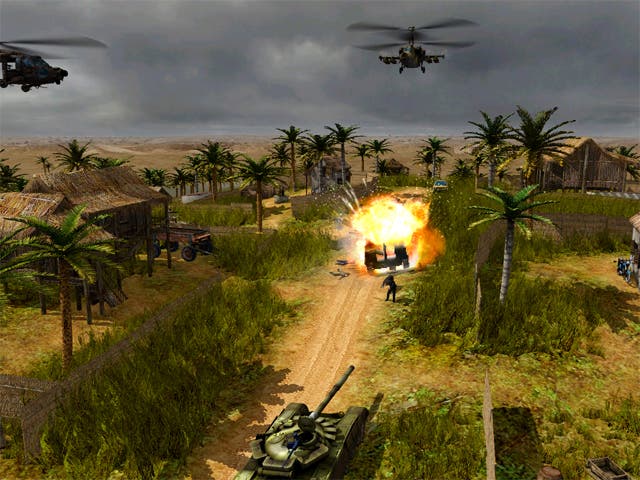Joint Task Force
Talking war with the creators of Vivendi's new RTS.
Vincent Van Diemen, the producer of forthcoming RTS Joint Task Force, is a man who likes to ask questions. Some of these questions relate to big, important, global issues, such as what really causes wars, where they're really fought and what role the media plays in it all. Others are of a rather less important nature - such as why, more than three years after its release, people are STILL playing Command & Conquer Generals. But the question that appears to be pressing most on Van Diemen's mind right now, as you might expect, is whether or not people are going to like his new game.
Specifically, he wants to know what Eurogamer thinks of it. We've just been given an hour-long presentation of JTF, and as we sit down to interview Van Diemen, the first thing he says is: "I always do the first question. So what did you think of the presentation?"
Developers always seem to like asking journalists questions like this, and they're not always easy to answer, especially if you've been brought up to be nice and polite and not to criticise things that people have spent entire years of their lives working on and haven't even finished yet. But who cares?
So we tell Van Diemen that this is the second time we've been given a preview of JTF, and that to be honest, it's still hard to work out what makes this game different; why RTS fans should be interested in JTF more than all the other games out there, and all the other ones that are on the way. What sets it apart?
"So you immediately turn it around, you turn it into a question for me," he chuckles. So he's seen through our brilliant ploy. But who cares. What's the answer?
"Okay, so I would say that Joint Task Force, first of all, is much more technical - that's the biggest thing. It's much more low scale; we have different resources; and we have this battlefield delivery instead of screens between missions to order your units."
Taking control

There's a lot of micro-managing to do, basically. Not so much when it comes to resources - you only really have one, money, of which more later - but when it comes to actually playing battles out. You can direct individual soldiers exactly where you want them to position themselves, for example, and order them to go prone if necessary. You can tell them which weapon to use. You can place tanks and vehicles exactly where they need to be, you can build roadblocks, and you can directly guide vehicles through minefields, to give a few more examples.
The direct control system is one of the ways in which the team behind JTF is trying to solve the problem of pathfinding - which, Van Diemen believes, has "never been done right by any game. And we are definitely aware of that; we're implementing a completely different system of pathfinding which we sort of took from FPS games. It's a totally different way of doing it."
So have they finally solved the problem? Well, nearly... "Pathfinding is never going to be perfect, that's for sure," Van Diemen concedes.
"But that doesn't mean you don't have to put a lot of effort in to make it as good as it can get. This is one of the main reasons we implemented the direct control features."
Let's say you're on a road, Van Diemen says, with two Abrahams tanks and an anti-air unit, and you want them lined up perfectly. With the point and click system, that's never quite possible, but with the direct control system, "It's all so much easier. We still have a lot of work to do, but we can optimise it, and the direct control is there to relieve the frustration you may have.
Have it your way

The other advantage of the micro-management feature is that it's designed to suit different playing styles - or so we were told in the presentation, where the speaker said that it might take one player half an hour to finish a game, while another player might take five or six hours. Which, frankly, sounded like a bit of nonsense to us, as we inform Van Diemen.
"That's a typical thing for this guy! That's very much exaggerated," he admits. The fact is, JTF - certainly when it comes to the single player campaigns - is not a game that allows you to gather together a load of tanks, then send them all bundling in to sort it all out in one go.
"I don't see any level where rushing would work. If you have only ground troops, you are limited to where you can go - roads and whatever. If you have a helicopter, you can fly over buildings, over mountains... So if you find a good way to deal with that, I'm sure there's a difference [in playing time], but it's not ranging from half an hour to five hours." The average time, apparently, is about an hour and a half, and there are 20 missions to complete.
The bottom line, according to Van Diemen, is that JTF takes "A much more low-scale, tactical approach that's definitely different. If you just select your units and send them forward, that's going to be the end of your mission; that won't work for JTF."
That's partly because all the maps, which seem to be rather impressive in terms of scale, are divided into sectors. The next sector won't open up until you've completed all your objectives in the current one. Then you'll need to "Look ahead of you, scan through the new sector, see what's there, regroup your troops, repair them, resupply the ammo, maybe have some reinforcements fly in, create your new troop formation... It's much more technical."
Money talks

Since you'll spend so much time managing and controlling your troops, it's probably a good thing that you won't have to pay too much attention to your resources; or rather, resource. There's no wood chopping or gold mining here - just good old cash.
So where does that cash come from? Well, from the countries who have established the Joint Task Force, which is a new anti-terrorist unit led by your character, Major Matthew O'Connell. He's a former CIA field agent, Van Diemen explains, who joined the JTF because "He's an idealistic guy; he still thinks that you can make a difference by being a soldier, that you can fight for something good. He thought that when he was working for the CIA - but he got given dirty work, and he had some doubts."
The other main character in the game is a female news reporter. "We thought it would be interesting to create these two main characters, this journalist and this Matthew O'Connell, who are not as different as they initially think they are. They meet each other and..."
Oh, crikey. Please don't tell us they fall in love. "No, no!", says Van Diemen, "This is not a teen movie! They think they have very different ideas and ethics, but they sort of grow towards each other throughout the game. But they don't fall in love, no!"
Thank goodness for that. The point is, Van Diemen explains, that the relationship between the war machine and the media is a key part of the game - and its anti-war theme. "In movies it's a very common thing to have this theme - Deerhunter, Apocalypse Now, Full Metal Jacket... There's a lot of those movies out there, but it's very uncommon for games, and we wanted to do that."
JTF is full of references to recent conflicts, with missions taking place in Somalia, Bosnia, Afghanistan, Colombia and Iraq. "Last time we met, I remember you asking about the ethical thing, that there are very strong references to what is going on right now," Van Diemen says; and once again, he's keen to reiterate that this is an anti-war game.
GTA: Baghdad

But at the end of the day, it's still a game; and, some might argue, it's a game that makes war fun, that suggests it's great to be fighting foreigners, controlling troops and going round shooting people...
"That's true. Basically this whole theme and this whole story, you can forget about it. In the end it's still a game," Van Diemen concedes.
"But the same thing goes for GTA - if you like, you can order people out of their cars and take off in them... It doesn't mean you approve of that in real life."
But isn't GTA set in a fictional world, or at least a city with a fictional name, whereas JTF uses real situations? "Not real situations," Van Diemen argues.
"The setting is real, but the setting in GTA is real too. We call it Afghanistan or Iraq; in GTA, they don't call it Los Angeles, but it's exactly the same thing. There are some references to real-life events - we have a prison break in one of the Afghanistan missions, for instance. But we're telling a very different story.
"The overall theme of the game is that when you're fighting a war, especially taken from the perspective of this main character, you're not fighting against those people that are running around with machine guns in Somalia. The real fight takes place on a much higher level, whether it's oil or drugs or whatever."
Time for more questions: "What can you say about all these big companies in America that build tanks and Apache helicopters? What's their role? How would they buy their groceries if there's no war?
"What about CNN? If CNN doesn't have a war to cover, what are they going to show you? The actual war is not on the street. There's a layered structure on top of that, and that's where the real war is created."
Media guardian

And that's certainly the case with Joint Task Force, in which the media plays a key role. There's a media bar, for starters, at the top of the screen, which displays how positively or negatively you're being portrayed. The better your reputation, the more funding the JTF will receive - and vice versa.
So if you rescue a load of red cross workers without too much bloodshed, the cash will come flooding in; if you kill civilians or blow up a church, or allow one of your men to get killed, it'll start to dry up. The JTF's investors can even take away money you've already received if you perform particularly badly. In short, it pays to behave yourself, because just like with real life wars these days, the world is watching.
As you've probably gathered by now, the single player mode of Joint Task Force is not designed for players who like to run around with all guns and tanks blazing, destroying stuff like there's no tomorrow. Which there won't be for anyone who gets in the way. But the multiplayer game is a different story - if you want it to be.
Up to eight players can compete against each other in four teams, and according to Van Diemen, there are "unlimited multiplayer modes." That's because you can alter the game's 'Rules of Engagement' in all manner of ways, to "basically create your own games.
"There are so many different options. Of course you can set perameters for what kind of reinforcements you allow and how you get funding; you can set the amount and the frequency with which it comes in. And because the map is divided into sectors, you can set it so that one sector closes down every five minutes. So just before it closes, it starts flashing, and you end up being in a very tight spot fighting each other," he explains.
"It's really more or less unlimited; and because the whole setup system for multiplayer is so flexible, you can turn it into a tank rush game if you want."
There's also a two-player co-op mode, but there are less options available to you here: "The mission structure is the same as the single player campaign, with the same resources - you just have to divide them."
Community building

Van Diemen says the multiplayer part of the game is very much his baby, and that he's keen to build up a strong community around JTF. "I try to keep track of everything; whenever I find the time I'm on the forum. From a gamer's perspective - and I'm still a gamer - if you look at which RTS games people are playing, they're still playing Command & Conquer Generals. I mean, why, for God's sake? It's out there for, I don't how long already; it's up to the standard as far as gameplay's concerned, not as far as graphics are concerned.
"So why wouldn't we try to create interest for those people to move over to JTF? This is why we put a lot of time into these multiplayer modes. For me, community is very important."
It's especially important because Van Diemen wants this to be the start of a whole new RTS series. "We are already looking at doing an expansion pack, maybe half a year after the game comes out. We had some plans a long time ago to add a campaign in Indonesia, but those are rough ideas - we'll have to look at that once we're done with this."
And then? "Unless this game fails big time for whatever reason, there will definitely be a JTF 2."
From what we've seen so far, it doesn't look like Joint Task Force is likely to fail. True, it's unlikely to prove popular with those who like their RTS games fast, furious and full of destruction - but then even they might be attracted by the wide range of options available in the multiplayer mode. And for those who prefer to take their time, to spend longer thinking about their next move, and to take direct control of what's happening, there's certainly a lot of appeal here.
But back to our original question: is there much which sets JTF apart from other RTS games? Perhaps not a great deal, if you're talking about the basics of the actual gameplay mechanics, or the way the game looks (very pretty though it is). However, the game's anti-war theme, and the way in which the media plays a role, are certainly intriguing. Maybe it's not so much how Joint Task Force looks or plays that sets it apart, but the fact that it's exploring ideas about the nature of war and how it has changed. And that's certainly not something you'll find in a lot of RTS games out there.








